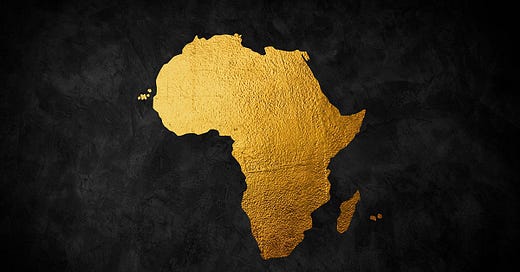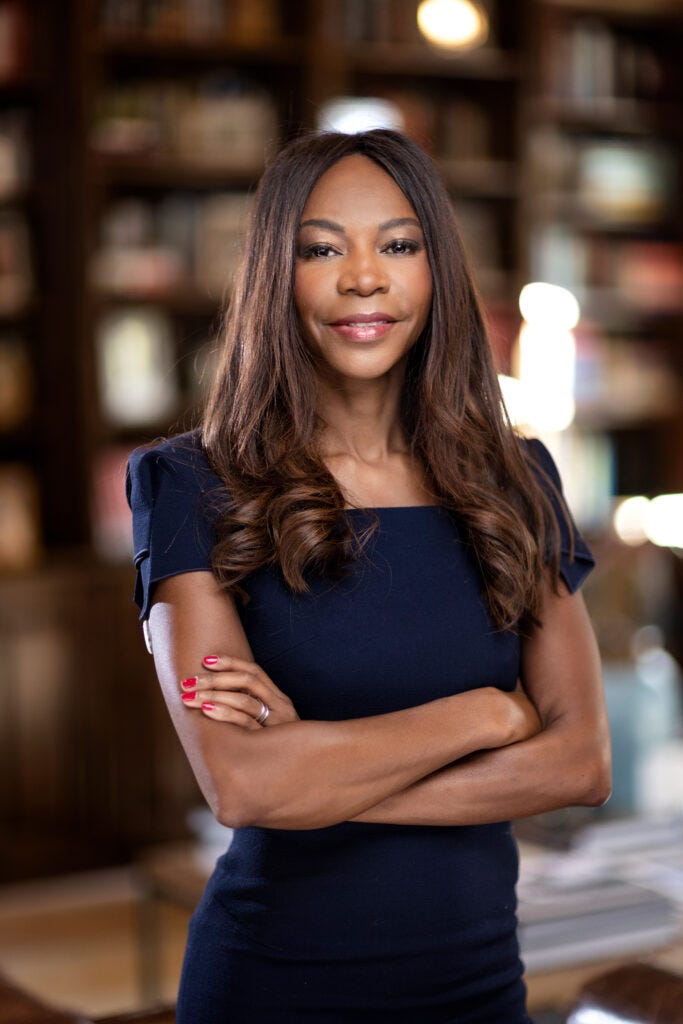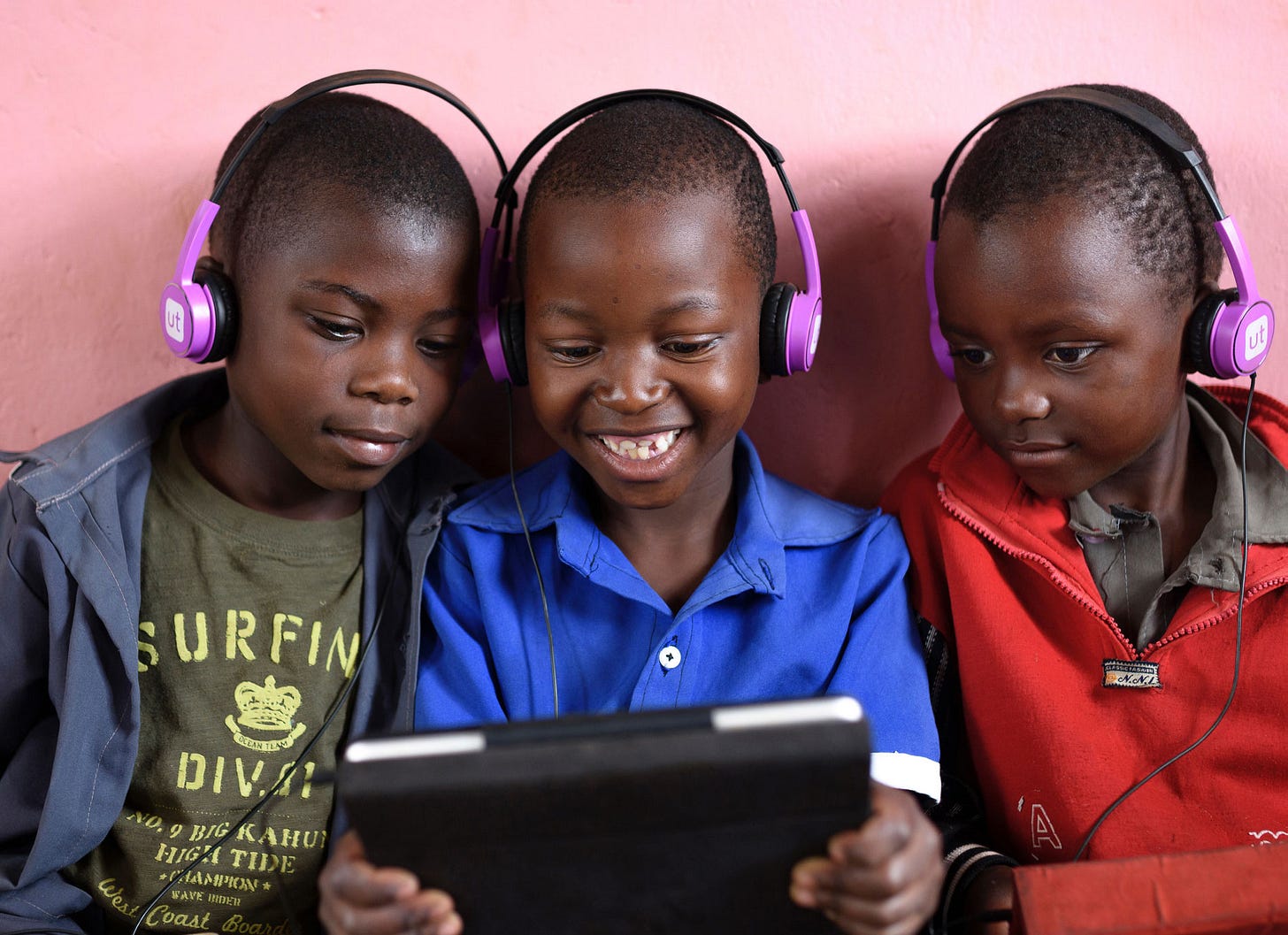Writing about Africa is tricky. The continent’s fifty four nations defy easy generalization: sub-Saharan Africa is very different from North Africa, which is very different from Francophone West Africa.
We’d never lump together Europeans (Italians, Spaniards, Germans, etc.) or Asians (Chinese, Korean, Japanese, etc.) in quite the same way we tend to categorize Africans under one monolith. For many Westerners, the word itself—Africa—simply conjures up half-baked vacation plans (all those The Lion King-inspired safaris) OR guilt-ridden pity (all the wars and the famines that Bono told us about).
Africa is not one place, but many places; not one people, but thousands of peoples. And yet there are common threads across what is—by almost any measure—the world’s poorest continent. One of those threads is aid, the injection of foreign dollars into broken economies: from 1990 to 2022, Africa received approximately $1.2 trillion in aid. That’s a lot of money!
To understand why Africa has received so much aid, you have to appreciate the challenges its countries face. The Sahara Desert physically isolates large swaths of the continent from global trade networks. Landlocked countries across the interior struggle to access coastal ports, pushing up costs and reducing opportunities to export goods abroad. Despite vast mineral wealth, natural resources often enrich outsiders more than Africans. Economies are fragmented, institutions are weak, and wars are commonplace. And, oh yea, colonialism and the slave trade left behind a legacy of exploitation, corruption, and cruelty.
Given this backdrop, the need for aid—significant, life-saving financial aid—couldn’t be more obvious. Aid is how the West absolves itself of its sins and its guilt. Jesus said, “If anyone has material possessions and sees a brother or sister in need but has no pity on them, how can the love of God be in that person?” Surely, our governments must give. And, in the meantime, we will live our comfortable lives in the first world. After all, we have given: what more can we do?
Of course, the reality is messier than this, and the attitude I’m framing above is overly simplistic. Aid is a hotly debated topic; it is deeply complex and fraught with conflicting data and tightly held opinions. Let’s tumble down this controversial rabbit hole together.
This is our uncomfortable quest: to understand how we might uplift the people of African countries in ways other than governmental aid.
What’s Wrong with Aid?
The British economist Paul Collier, writing in The Bottom Billion, summarizes the controversy around aid:
What is it about aid that causes such intense political disagreements? It seems to bring out the worst in both left and right. The left seems to want to regard aid as some sort of reparations for colonialism. In other words, it’s a statement about the guilt of Western society, not about development. In this view, the only role for the bottom billion is as victims: they all suffer from our sins. The right seems to want to equate aid with welfare scrounging. In other words, it is rewarding the feckless and so accentuating the problem. Between these two there is a thin sliver of sanity called aid for development. It runs something like this: We used to be that poor once. It took us two hundred years to get to where we are. Let’s try to speed things up for these countries.
Collier lands on a seemingly reasonable position— the accelerationist view—what we might call, “Aid with caveats.” Advocates for aid argue that financial infusions could help African nations accomplish in a few decades what took Europe and North America generations of industrial and infrastructural upheaval to achieve. They point to several success stories: the near-eradication of polio in Nigeria, the proliferation of HIV/AIDS treatment in South Africa, the jumpstarting of agriculture and economic development in countries like Malawi, Botswana, and Rwanda.
Proponents of aid have suggested a “Marshall Plan for Africa”: injecting MASSIVE sums of capital worked in Europe following World War Two, so we should do the same thing in an African context. Indeed, for a few decades, particularly from the early 2000s until the mid-2010s, several sub-Saharan economies registered promising growth—fueled in part by strong commodity prices and, in some cases, better governance aligned with external donor investments.
But, since 2014, that momentum has slowed. Africa is not Europe, with its preexisting free markets and longstanding institutions. Meanwhile, countless billions of aid dollars have vanished into the coffers of despots, have been wasted on poorly conceived development projects, or have simply evaporated in bureaucratic overhead. Even in states led by more scrupulous politicians, stringent conditions attached to international loans have encumbered domestic policy and left little room for organic reforms.
It is this patchy, often opaque impact of aid that has drawn the ire of critics. One of the most vocal is the Zambian economist Dambisa Moyo, who has become famous—some would say infamous—for her 2009 book Dead Aid. She was born in Lusaka and earned advanced degrees in finance and economics before working at the World Bank and Goldman Sachs, experiences that shaped her skepticism of how money moves around the world. Bill Gates once characterized her arguments as “promoting evil,” a far-too-severe condemnation. If one actually parses Moyo’s writing, it’s clear that while her rhetoric is often stark, she’s not arguing that Africa should never receive outside help. Instead, she challenges a particular type of perpetual, government-to-government aid (what she calls “open aid”) that she believes cements dependency and fosters corruption.
Dambisa Moyo
Why does Moyo oppose certain forms of aid?
Her critique is rooted in historical observation: relentless infusions of unaccountable cash can hobble the very sectors that need to thrive—independent businesses, local investment channels, and home-grown financial markets. In her view, if countries become conditioned to rely on foreign grants or low-interest loans, their own institutions have little incentive to develop robust regulatory regimes.
Her stance is sensible, but her words are often harsh, hence Gates’ “promoting evil” comment. In Dead Aid, Moyo writes: “Africa is addicted to aid. For the past sixty years it has been fed aid. Like any addict it needs and depends on its regular fix, finding it hard, if not impossible, to contemplate existence in an aid-less world. In Africa, the West has found its perfect client to deal to.”
Frankly, this is mana from the Gods (a Harvard-educated African woman economist!) for handout-hating conservatives. And yet there are countless horror stories of stolen aid. Collier gives the example of an expenditure tracking survey in Chad that showed that less than 1 percent of the money released by the Ministry of Finance for rural health clinics actually reached the clinics. There was the infamous “Cashgate scandal” in Malawi: in 2013, an audit revealed that millions of dollars in public funds had been siphoned off through fraudulent payments to phantom companies and complicit officials. Sani Abacha, a military dictator who ruled Nigeria with an iron first during the 90s, notoriously funneled away billions in foreign loans and aid into private offshore accounts.
But, in other contexts, aid clearly helps. Countries like Ghana, Mozambique, and Ethiopia have seen robust GDP growth—often topping six or seven percent annually—in part because external funding underwrote vital infrastructure projects and provided breathing room for local industries to expand. Debt relief initiatives championed by the IMF and World Bank also helped free up national budgets, enabling governments to bolster social spending and stimulate new sectors. Daron Acemoglu, co-author of Why Nations Fail, has emphasized that these gains hinge on whether aid is funneled through inclusive institutions. In contexts where local leaders dedicate resources to legitimate development goals—expanding trade networks, promoting education, and incentivizing entrepreneurship—foreign capital can function as a catalytic force.
Part of the problem here is semantic: what do we mean when we say “aid”? This single word can encompass wide-ranging projects—from urgent disaster relief to the long-term financing of roads, clinics, and schools. It can refer to multilateral loans from the IMF or World Bank, philanthropic grants from NGOs, or private-sector partnerships.
Moyo is not simply saying “Aid bad.” She parses the issue quite clearly in her book:
Broadly speaking there exist three types of aid: humanitarian or emergency aid, which is mobilized and dispensed in response to catastrophes and calamities – for example, aid in response to the 2004 Asian tsunami, or monies which targeted the cyclone-hit Myanmar in 2008; charity-based aid, which is disbursed by charitable organizations to institutions or people on the ground; and systematic aid – that is, aid payments made directly to governments either through government-to-government transfers (in which case it is termed bilateral aid) or transferred via institutions such as the World Bank (known as multilateral aid).
Moyo takes issue with this final category: the loans and grants flowing from Western governments to African governments. She says that aid programs that are “short, sharp, and finite” have a good track record. But open aid, according to Moyo, simply hasn’t worked:
Study, after study, after study (many of them, the donors’ own) have shown that, after many decades and many millions of dollars, aid has had no appreciable impact on development. For example, Clemens et al. (2004) concede no long-term impact of aid on growth. Hadjimichael (1995) and Reichel (1995) find a negative relationship between savings and aid. Boone (1996) concludes that aid has financed consumption rather than investment; and foreign aid was shown to increase unproductive public consumption and fail to promote investment.
Here’s the thing: whatever you think about aid—and Moyo certainly has her critics—it undeniably can create a false sense of “having done something.” When you know that your country’s taxes are flowing somewhere in Africa, it’s all too easy to assume your good deed is done, your conscience is clear. On the receiving end, “free money” can encourage complacency, stunt local institutions, and embolden leaders who use foreign dollars to consolidate political power rather than rebuild roads or schools.
What else is there to do? What can you do?
Solutions Other Than Open Aid
For her part, Moyo encourages “trade over aid,” the promotion of local bond markets, and the fostering of diaspora investment channels. Africa desperately needs private capital inflows. Global firms with an appetite for risk can provide not only money, but also technical know-how and advisory support.
But even these solutions can feel a little removed, a little too macro for well-meaning observers. Everyday donors want to see tangible, grassroots results. This is where venture philanthropy can play a role.
Venture philanthropy is a form of impact investing in which nonprofits operate more like savvy investors—vetting prospective projects, measuring impact rigorously, and channeling resources to the most promising local organizations or tech start-ups. If small-scale entrepreneurs can secure seed funding and guidance, they might develop the next mobile payments platform or agricultural supply-chain innovation. Rather than perpetuating dependency, this kind of targeted support helps people build and own the mechanisms of their uplift.
The African Venture Philanthropy Alliance (AVPA) is a leader in this space. They connect socially minded investors with vetted opportunities through a deal-sharing platform, creating communities around thematic challenges and offering training in impact investing. In an interview with African Business, AVPA’s CEO Frank Aswani sums up how grants and various forms of aid can serve as a stepping stone to private capital:
“So, for example, in the early stages of supporting businesses or innovation which are still unproven, you need grants because grants can have the appetite for risk and they can take those models from an idea to a proof of concept,” he explains. Once proven, commercial capital can come in to deliver scale and multiply the impact. “So what we do is bring all of them together and we try to put over the shared vision, and the value and additionality that they can each create by investing together at different stages of life cycles for social investments, rather than going it alone,” he adds.
There are some great success stories in venture philanthropy. I’ll quickly share two, before finishing up with other ways you can help support economic flourishing in African countries.
Founded in 2006, One Acre Fund is a social enterprise helping smallholder farmers in East Africa boost their productivity and income. It provides asset-based loans, training, and market access to farmers across Kenya, Rwanda, Burundi, and several other countries, reaching more than 4 million farm families. Participants typically see their profits increase by about 33% compared to non-participants. You can support their impactful work here.
Imagine Worldwide is an organization I know personally and have supported. They're addressing Africa's education crisis by providing schools with tablets preloaded with educational software specifically designed to boost literacy and numeracy skills. This tech-driven approach allows students to learn at their own pace and has shown remarkable effectiveness, significantly improving learning outcomes in under-resourced schools, where the student-teacher ratios are often 100+ to 1.
For many of the children that Imagine reaches, it’s their first time seeing and interacting with a screen-based tablet; you can imagine how magical that is, especially as they dive into educational software in their own language. Imagine is doing exciting work in Malawi and other countries, and you can support their mission here.
We’ve reached the end of our journey!
I hope it’s clear that aid is a complex issue—not something to eliminate entirely, but certainly an approach that requires careful thought. Whenever possible, aid should be complemented and eventually replaced by local, sustainable initiatives.
Here’s Quest 17:
Uplift Africa
Support organizations working in Africa that adopt a venture philanthropy mindset; see the AVPA website for some examples.
Buy directly from African entrepreneurs: support small businesses through platforms like Made51 or African-made products on Etsy.
Check in with an Africa-focused publication from time to time: read The Continent or African Business to stay informed and connected with what's happening on the ground.
As always, thanks for reading!









